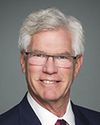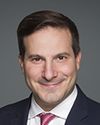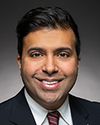Thank you, Mr. Chair.
Indeed, it is good to be appearing before this committee in person.
I want to start by acknowledging that those of us on the Hill are gathered on the traditional territory of the Algonquin people.
Thank you for inviting me here today.
Colleagues, I've been paying close attention to the testimony presented to this committee over the past few months. You have heard compelling and enlightening testimony, particularly with regard to remarkable local initiatives that play a significant role.
You heard about OPK, the Winnipeg‑based social service organization. You heard that indigenous men and women have been able to leave gang life as a result of the program's outreach and their access to resources and community connections.
You heard about the Bear Clan Patrol, which is also located in Winnipeg and which provides security for the indigenous community and helps to keep the peace in a supportive manner.
You heard about STR8 UP, an organization that serves Saskatoon's at‑risk indigenous community, works with former gang members and their families, and supports individuals embarking on a healthier path.
The figures don't lie. As a result of these types of programs, thousands of hours a year of personal skills development and job training have helped promote personal growth, a sense of hope and an alternative to gang life.
At the provincial level, you heard about the work done by British Columbia and the Combined Forces Special Enforcement Unit. This unit is paired with a program to end gang life. The goal is to provide support to gang members to help them leave the lifestyle.
You heard about initiatives in Quebec that promote strong action through projects such as Operation Centaur. In that province, the project is helping to provide more police officers, medical examiners and correctional officers to support responses and information sharing. It's also bringing law enforcement agencies together to conduct investigations, prevent gun violence and reduce smuggling.
Mr. Chair, I warmly welcome the attention you and this committee have been paying to initiatives that have been put into place across the country. I look forward to discussing them, and much more, with all partners at the upcoming engagements that we have across the country.
Colleagues, along with the positive signs of progress, you've also heard first-hand accounts of the shared challenges we all face in tackling gun violence. I point to the testimony of Vancouver Police Department Staff Sergeant Michael Rowe. He pointed to the challenge of ghost guns, or firearms produced in part by 3D printing. They are manufactured or assembled from components without a serial number or other markings, making them difficult to detect by conventional systems and difficult to trace. It's a reminder that we're all operating in an evolving and complex environment. It's a reminder that through times of change, we all need to work closely together at every level and in every community.
At my last appearance, I provided an overview of how the federal government is playing a leadership role to do just that. I noted that we've introduced the strongest measures to fight gun violence our country has ever seen. I highlighted how we focused on controlling the use and possessions of firearms. For example, through measures now in place allowing for lifetime background checks, they include criteria that must be considered in deciding whether to grant a firearms licence. I pointed out the ways in which we're limiting access to firearms deemed inappropriate, for example, our ban of over 1,500 models and variants of assault-style firearms with a buyback regime on the way. I talked about how we're tackling illegal firearms, for example, by committing to increase the maximum penalty for firearms trafficking, smuggling, and related offences from 10 to 14 years imprisonment. I spoke about our efforts to reduce gang membership and violence. Those prevention efforts are essential, because the fight involves more than just enforcement.
As my colleague, Minister Blair, has often said, “You can't arrest your way out of the problems on our city streets.” That's why, to date, we've delivered more than $115 million to the provinces and territories to support prevention, intervention, and the suppression and enforcement activities under the gun and gang violence action fund since 2018. I'll add that we've also allocated $250 million over five years directly to municipalities and indigenous communities that have a demonstrated history of gun and gang-related harm, who will receive funding to bolster gang prevention and intervention programming.
I also talked about how enforcement investments to deter smuggling and trafficking are making a difference. As members know, the CBSA seizes large quantities of firearms every year from United States citizens, mostly from non-compliant travellers attempting to retain their personal firearms while travelling.
Firearms tracing is also a key tool in determining the sources of and diversion routes for illegal firearms. Approximately 21,000 firearms are seized annually by law enforcement. Our $125 million in support for the RCMP and CBSA to stop illegal guns at their source and to detect and disrupt gun smuggling is already paying dividends, with over 1,000 firearms seized at the border last year.
I also highlighted that we have invested an additional $312 million over five years to enhance our capacity to better identify, disrupt and prevent firearms from entering the illicit market. That includes $15 million to increase the RCMP's capacity to trace firearms and over $40 million for anti-smuggling activities, which includes building a new Canadian criminal intelligence system that will help law enforcement to target and disrupt criminal activity.
We've seen concrete evidence of the difference these investments are making, complementing the testimony you've heard. Just look at the results of the CBSA's investigation into 3D printed firearms last year. It showed that the work of the CBSA and RCMP, after detecting and intercepting undeclared firearms parts in Mississauga, led to seizures, warrants and arrests through strong action at the border and collaboration with many partners.
Mr. Chair, at the same time, I acknowledge there is more work to be done. I want to reinforce the government's commitment to collaborate with the provinces who want to take action in banning handguns, an issue I discussed with my provincial and territorial colleagues last week at our federal, provincial and territorial conference.
While this committee studies the issue of gun control, illegal arms trafficking and the increase in gun crimes committed by members of street gangs, I look forward to your consideration and debate on new firearms legislation that we will table soon.
I want to close by again thanking all of the members of this committee for their thoughtful work, and I look forward to taking your questions and comments.
Thank you.




